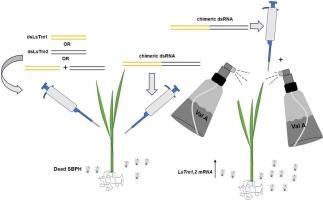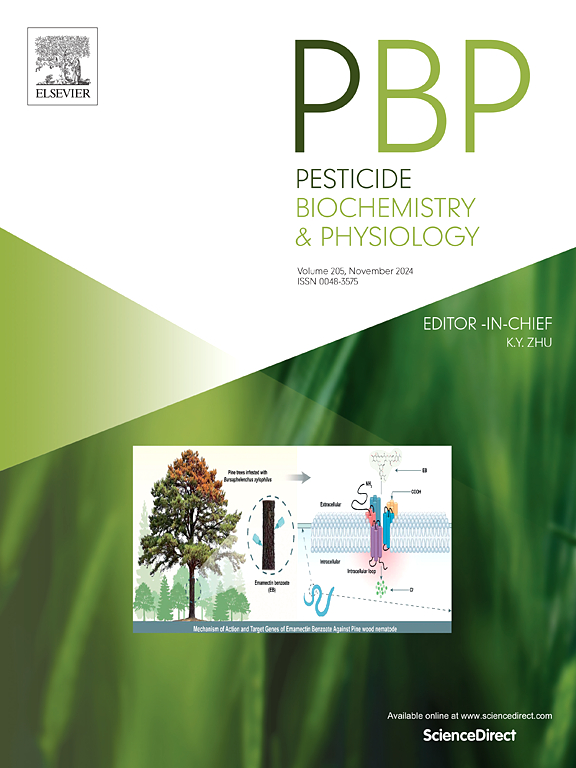联合应用瓦里达霉素 A 和靶向树胶酶基因的 dsRNA 可增强对 Laodelphax striatellus 的杀虫活性
IF 4.2
1区 农林科学
Q2 BIOCHEMISTRY & MOLECULAR BIOLOGY
引用次数: 0
摘要
小褐飞虱(SBPH)(Laodelphax striatellus)对水稻作物构成严重威胁,因此需要创新的害虫控制策略。本研究评估了有效霉素 A(Val A)和针对三卤酶基因(LsTre1 和 LsTre2)的 RNA 干扰(RNAi)在控制 SBPH 方面的潜力。我们的研究结果表明,Val A 处理水稻秧苗会导致 SBPH 出现剂量依赖性死亡。同时,Val A 会诱导 LsTre1 和 LsTre2 的上调,这表明这是一种补偿反馈机制。此外,与单独的 dsLsTre1 和 dsLsTre2 或混合 dsRNA 相比,叶面施用以 LsTre1 和 LsTre2 为靶标的嵌合 dsRNA 表现出更高的杀虫活性。值得注意的是,由于嵌合 dsRNA 抑制了 Val A 诱导的 LsTre1 和 LsTre2 的上调,联合应用 Val A 和嵌合 dsRNA 增加了 SBPH 的死亡率。这些结果表明,联合应用 Val A 和针对树胶酶基因的嵌合 dsRNA 可能是一种有效的 SBPH 控制策略。本文章由计算机程序翻译,如有差异,请以英文原文为准。

Co-application of Validamycin A and dsRNAs targeting trehalase genes conferred enhanced insecticidal activity against Laodelphax striatellus
The small brown planthopper (SBPH), Laodelphax striatellus, poses a significant threat to rice crops, necessitating innovative pest control strategies. This study evaluated the potential of validamycin A (Val A) and RNA interference (RNAi) targeting trehalase genes (LsTre1 and LsTre2) in controlling SBPH. Our results demonstrated that Val A treatment of rice seedlings led to a dose-dependent mortality of SBPH. Concurrently, Val A induced the upregulation of LsTre1 and LsTre2, suggesting a compensatory feedback mechanism. Furthermore, foliar-applied chimeric dsRNA targeting LsTre1 and LsTre2 exhibited higher insecticidal activity than individual dsLsTre1 and dsLsTre2 or mixed dsRNAs. Remarkably, co-application of Val A and chimeric dsRNA increased SBPH mortality due to the suppression of Val A-induced LsTre1 and LsTre2 upregulation by chimeric dsRNA. These results suggest that the co-application of Val A and chimeric dsRNA targeting trehalase genes could be an effective SBPH control strategy.
求助全文
通过发布文献求助,成功后即可免费获取论文全文。
去求助
来源期刊
CiteScore
7.00
自引率
8.50%
发文量
238
审稿时长
4.2 months
期刊介绍:
Pesticide Biochemistry and Physiology publishes original scientific articles pertaining to the mode of action of plant protection agents such as insecticides, fungicides, herbicides, and similar compounds, including nonlethal pest control agents, biosynthesis of pheromones, hormones, and plant resistance agents. Manuscripts may include a biochemical, physiological, or molecular study for an understanding of comparative toxicology or selective toxicity of both target and nontarget organisms. Particular interest will be given to studies on the molecular biology of pest control, toxicology, and pesticide resistance.
Research Areas Emphasized Include the Biochemistry and Physiology of:
• Comparative toxicity
• Mode of action
• Pathophysiology
• Plant growth regulators
• Resistance
• Other effects of pesticides on both parasites and hosts.

 求助内容:
求助内容: 应助结果提醒方式:
应助结果提醒方式:


